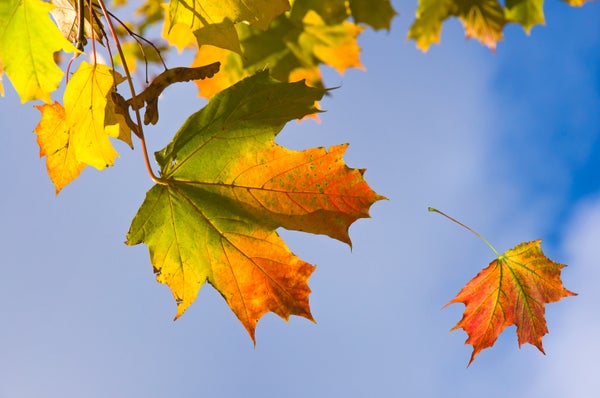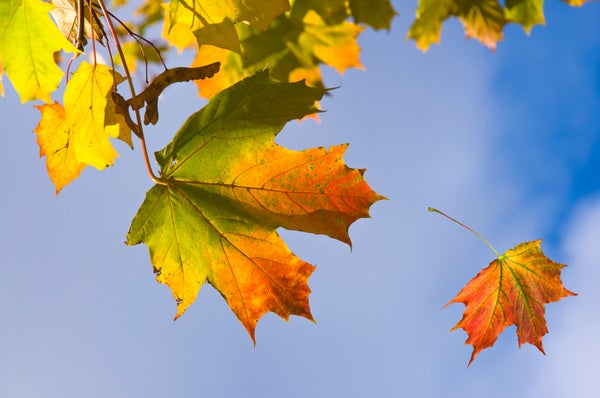October 18, 2024
4 min read
What Brilliant Fall Leaf Colors Tell Us about Tree Health and Climate
A tree’s fall palette offers a glimpse at its health and the weather it has experienced in a given year

Larisa Fedotova/Getty Images
Before the advent of pumpkin spice lattes and Halloween decorations, the most reliable indication of autumn’s arrival lay in the tree canopy as its greens gave way to yellows and reds and its leaves then fell away.
That process is shaped by weather both in the autumn and throughout the year, which means that individual years can produce strikingly different foliage displays. It also means that as climate change manifests in weirder conditions, fall will start to look different. Studying what’s happening and why could help scientists understand how trees and forests are faring at this key seasonal shift.
As the sun begins setting earlier and temperatures dip, “much like the rest of us, trees are identifying that it is autumn and that winter is coming,” says Amanda Gallinat, an ecologist at Colby College. For some trees, the onset of cold weather doesn’t change their survival strategy: most firs, pines and spruces will carry on as usual, looking more or less as green in winter as ever. But deciduous trees such as most oaks and maples follow a different strategy, shedding their leaves to endure the winter bare-branched.
On supporting science journalism
If you’re enjoying this article, consider supporting our award-winning journalism by subscribing. By purchasing a subscription you are helping to ensure the future of impactful stories about the discoveries and ideas shaping our world today.
These trees go bare because in winter’s harshness, leaves can’t store enough energy to make up for the water a tree loses through them. And by letting go of their foliage on their own schedule, deciduous trees can typically reabsorb some of the expensive nutrients in those leaves to reuse in the next growing season. The process shows up as the spectacle of fall foliage.
During the summer, leaves appear green because the predominant pigment of photosynthesis, called chlorophyll, reflects green light. But chlorophyll is full of nitrogen and other valuable components, so when they can, trees will pull the pigment out of their leaves as winter approaches.
In many trees, such as ginkgoes and honey locusts, removing chlorophyll reveals yellow pigment compounds called carotenoids. “Species that turn yellow have had those pigments all year, and we’re looking at the absence of the color green,” Gallinat says.
Other species, such as red maples and sweet gums, produce new pigments—red and purple anthocyanins—especially for the fall. “Those colored pigments are like a sunscreen for leaf tissue while the plants are retrieving nutrients from the leaf tissue,” says Yingying Xie, a plant ecologist at Northern Kentucky University. “They don’t have the chlorophyll to absorb light, so they don’t want the sunlight radiation damage—that’s why some species produce other kinds of color pigment to absorb or reflect the radiation.”
Foliage that turns brilliant yellow, orange, red or purple as days shorten therefore indicates a healthy tree wrapping up its growing season. But when the timing or color progression is off, that may signal the tree is struggling. “Because stress does seem to be part of it, early onset of fall color is often a really great indicator of the tree’s health,” says Christy Rollinson, a forest ecologist at the Morton Arboretum in Illinois.
Two main factors govern the transition to autumnal foliage: the length of the day and falling temperatures, especially at night. The precise balance tends to depend on the species, with some being more responsive to changing conditions than others.
But regardless of how a tree balances the environmental information it receives, sometimes it miscalculates. When something goes wrong, the result is less pretty. Serious drought in the summer can sometimes make trees unable to keep supporting leaves through the full growing season, leading them to drop green foliage. Wet autumns can encourage fungi and pests that can sap a tree’s resources and the vibrancy of its foliage. An early freeze that catches a tree unawares can do the same or can cause its leaves to turn straight from green to brown before falling off. That’s because freezing water rips open a leaf from the inside. “When a leaf freezes, it’s like putting a full water bottle in the freezer,” Rollinson says. “As that ice forms and expands, it breaks your water bottle.”
On the face of it, then, a warming climate might seem like a buffer for trees against losing leaves to an early frost. But it’s not that simple, and scientists still have a lot to learn about how extreme temperature and precipitation events can pile up during a year to impact fall foliage, Xie says. Overall, the outlook is grim for stunning fall foliage under continuing climate change. “We expect that as temperatures warm, we will see less vibrant autumn seasons,” Gallinat says.
One piece of that reduction in vibrancy comes from a lengthening of the foliage season. As fall temperatures become milder, different trees with different coolness thresholds for color changes will begin their winter preparations at more spread out times. In this way, you might see a few trees pop in color only to then drop their leaves before another group does the same.
“Trees are like people: they’re all weirdos.”
In addition, the changing makeup of forest ecosystems themselves will impact their usual fall display. Native species are exquisitely tuned to the environment they evolved in, so they could be caught off guard by unusual seasonal changes. In contrast, invasive species are more likely to be able to respond to these changes, lengthening their growing season in both the spring and the autumn, giving them a boost in resources compared with native species, Gallinat says. This phenomenon could further dilute beautiful foliage through the autumn.
Even after considering various factors, it’s difficult to predict the nuances of fall foliage because each individual tree is governed by its immediate environment rather than coordination with its neighbors. “It’s a great opportunity to go for a scavenger hunt where you live because there is often a huge variation in the timing of color,” Rollinson says. “Trees are like people: they’re all weirdos.”

